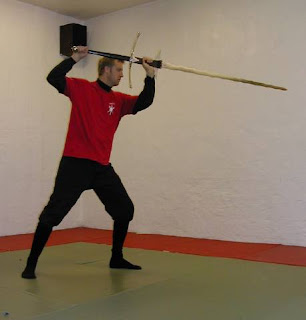

Excaliber – ah! the romance of the name - the mighty sword of the great king Arthur.
I got curious one day and decided to find out if there was a meaning to the name. And there is. It’s Latin.
EX: meaning “out of,” like, “expel,” or “ex-wife.” So you are “out of” the school or club, or “out of” your marriage or relationship.”
CALIBER: meaning “a mold,” like you cast ceramic or porcelain figures from a mold.
Hmm, Ex-caliber, “out of a mold….” Well that didn’t sound romantic at all. But if it was out of a mold – a mold of what? Could the sword have been a copy of some other famous sword?
Here I get into pure, but fun and interesting speculation. As my mind spun about the idea of the famous sword Excaliber I remembered my trip to Switzerland in 1991. My friend and I had just finished a tour and were waiting for a train to take us to Basil, where we would board a passenger liner for a three day tour down the Rhine River.
We had a few hours to kill and discovered the National Historical Museum of Switzerland just across the street from the train station in Zurich. It was a fabulous museum. They had just finished renovating three of their 6 major exhibits, one of which was a history of warfare. As we entered the hall, we passed a long line of mannequins dressed in all the different Swiss military uniforms through the centuries. In the hall was an incredible display of middle ages war weapons. What fascinated me most were the huge two-handed broadswords. They were massive, many as tall as I was or taller. I’m 5 foot 2 inches. Then you look at the armor and the uniforms and men of the middle ages weren’t much taller than me, about 5 foot, 5 inches on average. And I asked myself, where did this concept for a weapon come from? It couldn’t have been the Romans. They carried short, light weight, easy to carry swords. And of course, only the wealthy could afford such a large sword. Steel was expensive – and that much steel was very expensive. Besides, anyone who had the strength and expertise to wield such a sword would be a terror on the battle field. They could cut a man in two with a huge sword like that.
This from http://militaryhistory.suite101.com/article.cfm/the_long_sword_or_two_handed_sword#ixzz0naSAH4OO
“The two most famous users of these long sword types were the Scottish highlanders with their two handed claymores and the Germanic Landsknecht mercenaries. The most feared of the Landsknecht would be called a Doppelsöldner, (Double soldier) and would receive twice the pay of a regular fighter. These men would carry the zweihänder, a two-handed sword as long as a man was tall. Its main purpose was to down charging horsemen and cut off oncoming pike heads.”
Note, the most famous users were Scottish and Germanic.
I was puzzled for some time about those two handed swords – but just kept the info in the back of my head. Then, some years ago, when I was in the middle of reading all this Arthurian material, I happened to have the television on during some PBS program while I was puttering around the house. Some topic of politics was being discussed. I wasn’t paying much attention until the man being interviewed made some comment about the situation being like when the Goliath sword would be removed from the Temple and paraded around Jerusalem.
My mind churned! When the boy David had killed the Philistine giant Goliath, he had taken the man’s sword and cut off his head. How big, do you suppose, the sword of a 9 ½ foot giant would be? 5 foot? 6 foot? In ancient days, when you won a battle, you took booty from the enemy. It would only make sense for David to take Goliath’s weapons and armor. According to this man at least the sword was kept as a national treasure to Israel – and surely it would become a symbol of the kingship. But like so many treasures of Israel, it disappeared when the Babylonians despoiled Jerusalem and took the people captive to Babylonia.
Now we are back to the tradition of Jeremiah taking one of the daughters of king Zedekiah to the British Isles. What else might he have taken? What tokens of Kingship? If they did take the Goliath sword, by the time we reach the age of Arthur, that sword would be 1500 years old. It would be too brittle to take into battle.
It is said that Merlin forged Arthur’s sword. What if he made a mold from the original Goliath sword, then cast and forged a new sword? Then, he handed that massive beast to a 15 year old boy who could not only pick it up, but could wield it in battle. You’d make the lad your battle commander too!
The sword Excaliber was an important sword. It was noted by one scholar that when Gawain went about the country as a judge, he took the sword with him – a token of the king – meaning that what he did, he did in the name of the king.
That king became so powerful in the minds and hearts of men of that age that others, wanting power and glory for themselves, tried to be like him, making their own two-handed six foot long swords to take into battle. I can think of no other inspiration for such massive swords.
So, was the legend “Whoso Pulleth Out the Sword of the Stone and Anvil, is Rightwise King Born of All England?"
Or was it, Whoso has this Sword and this Stone, is Rightwise King!
Next: The Sword the Stone and the Mirror.
Photos from: http://www.thearma.org/essays/2HGS.html
